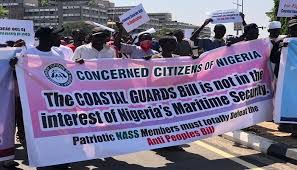Coast Guard clarifies policy on swastikas and nooses amid misreporting controversy

Coast Guard clarifies policy on swastikas and nooses amid misreporting controversy
The U.S. Coast Guard has addressed recent media reports claiming it would no longer classify swastikas, nooses, and other extremist symbols as prohibited. In official documents obtained by USA TODAY on Thursday, November 20, the Coast Guard described these images as “potentially divisive symbols,” prompting confusion and public concern.
According to the updated harassment guidelines, which are set to take effect on December 15, the service now labels nooses, swastikas, and flags associated with hate-based organizations as “potentially divisive.” Previously, any display of such symbols was formally investigated as a “hate incident.”
The revised policy states: “Potentially divisive symbols and flags include, but are not limited to, the following: a noose, a swastika, and any symbols or flags co-opted or adopted by hate-based groups as representations of supremacy, racial or religious intolerance, or other bias.” While these symbols may still trigger harassment investigations, they will no longer be categorized under a distinct “hate incident” label.
The Washington Post initially reported on the changes, suggesting the updates reflect the Trump administration’s more permissive stance on hazing and harassment within the U.S. military. The Coast Guard operates under the Department of Homeland Security, currently led by Secretary Kristi Noem.
However, Coast Guard officials were quick to push back against the Post’s interpretation. Acting Commandant Adm. Kevin Lunday emphasized that the reporting misrepresented the new guidelines. “The claims that the U.S. Coast Guard will no longer classify swastikas, nooses, or other extremist imagery as prohibited symbols are categorically false,” Lunday said in a statement to USA TODAY.
He added: “These symbols have been and remain prohibited in the Coast Guard per policy. Any display, use, or promotion of such symbols will be thoroughly investigated and appropriately punished. The Coast Guard is committed to maintaining a safe, respectful, and professional workplace. Symbols like swastikas, nooses, and other extremist imagery violate our core values and will be treated with the seriousness they warrant.”
Tricia McLaughlin, assistant secretary at the Department of Homeland Security, also publicly refuted the reporting, reinforcing that extremist imagery remains banned within Coast Guard facilities and operations.
The Anti-Defamation League (ADL), a leading organization combating antisemitism, condemned the Post’s report, stressing that swastikas have no place in workplaces or the armed forces. The ADL noted that the symbol, as used by Nazi Germany, is one of the most notorious emblems of hate and anti-Semitism globally. Similarly, the noose remains a painful symbol of racial terror, historically tied to the lynching of Black Americans.
“The hangman’s noose is one of the most powerful visual symbols directed against African Americans, comparable in emotional weight to the swastika for Jews,” the ADL said in a statement.
Political leaders also voiced concern. Rep. Bennie Thompson (D-Mississippi) condemned the notion that these symbols could be considered merely “potentially divisive,” calling them representations of genocide and racial terror.
As confusion surrounding the policy spread, the Coast Guard emphasized that it remains committed to enforcing its harassment and conduct rules rigorously, ensuring that all personnel operate in an environment free from symbols of hate and intimidation.
FAQ
Q: Are swastikas and nooses allowed in the U.S. Coast Guard?
A: No. These symbols remain prohibited, and any display may result in investigations and disciplinary action.
Q: What does “potentially divisive” mean in the new guidelines?
A: It refers to symbols and flags that may cause tension or offense but are still treated seriously under harassment policies.
Q: Did the policy change mean hate incidents are no longer addressed?
A: Hate incidents are still investigated, but they are no longer categorized separately under the label “hate incident.”
Q: Who oversees the Coast Guard?
A: The Coast Guard is part of the Department of Homeland Security, currently led by Secretary Kristi Noem.




